Alfa Romeo Giulietta 2013 Owner handbook (in English)
Manufacturer: ALFA ROMEO, Model Year: 2013, Model line: Giulietta, Model: Alfa Romeo Giulietta 2013Pages: 292, PDF Size: 13.06 MB
Page 111 of 292
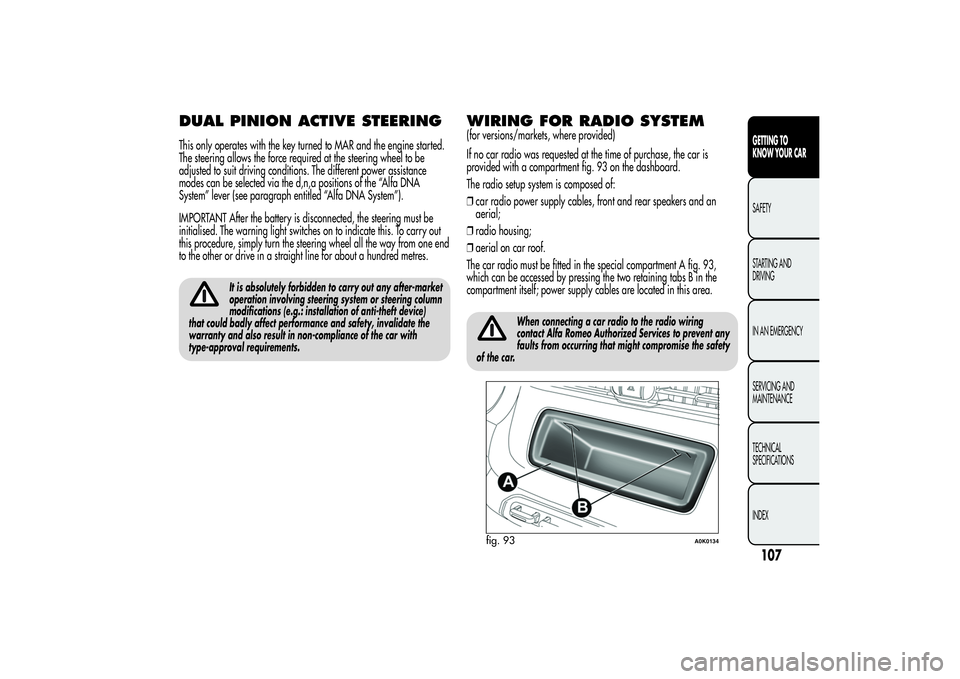
DUAL PINION ACTIVE STEERINGThis only operates with the key turned to MAR and the engine started.
The steering allows the force required at the steering wheel to be
adjusted to suit driving conditions. The different power assistance
modes can be selected via the d,n,a positions of the “Alfa DNA
System” lever (see paragraph entitled “Alfa DNA System”).
IMPORTANT After the battery is disconnected, the steering must be
initialised. The warning light switches on to indicate this. To carry out
this procedure, simply turn the steering wheel all the way from one end
to the other or drive in a straight line for about a hundred metres.
It is absolutely forbidden to carry out any after-market
operation involving steering system or steering column
modifications (e.g.: installation of anti-theft device)
that could badly affect performance and safety, invalidate the
warranty and also result in non-compliance of the car with
type-approval requirements.
WIRING FOR RADIO SYSTEM(for versions/markets, where provided)
If no car radio was requested at the time of purchase, the car is
provided with a compartment fig. 93 on the dashboard.
The radio setup system is composed of:
❒car radio power supply cables, front and rear speakers and an
aerial;
❒radio housing;
❒aerial on car roof.
The car radio must be fitted in the special compartment A fig. 93,
which can be accessed by pressing the two retaining tabs B in the
compartment itself; power supply cables are located in this area.
When connecting a car radio to the radio wiring
contact Alfa Romeo Authorized Services to prevent any
faults from occurring that might compromise the safety
of the car.
fig. 93
A0K0134
107GETTING TO
KNOW YOUR CARSAFETY
STARTING AND
DRIVING
IN AN EMERGENCY
SERVICING AND
MAINTENANCE
TECHNICAL
SPECIFICATIONS
INDEX
Page 112 of 292
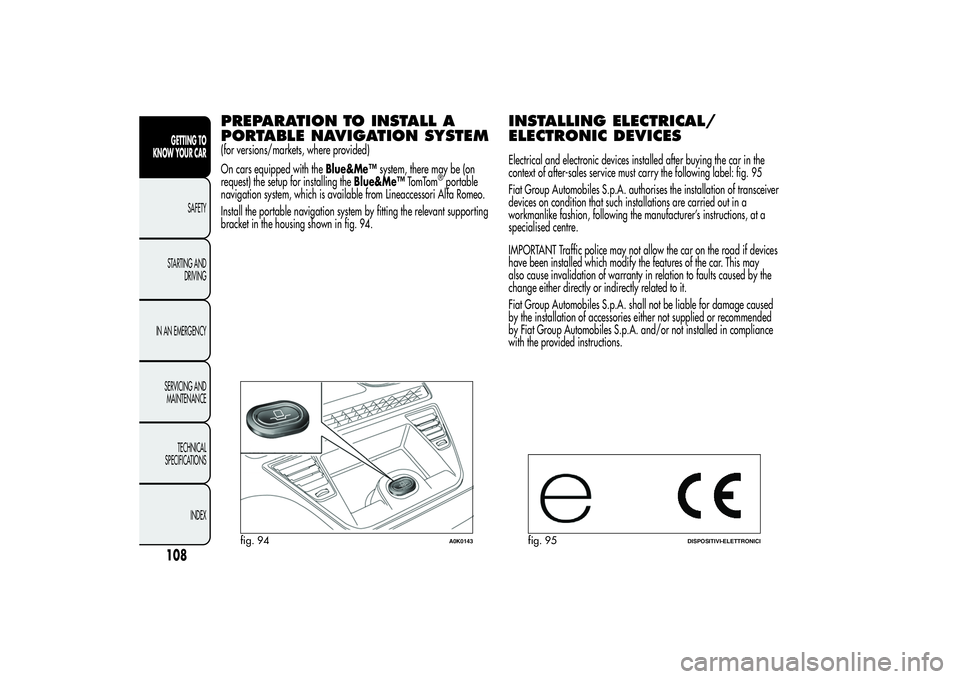
PREPARATION TO INSTALL A
PORTABLE NAVIGATION SYSTEM(for versions/markets, where provided)
On cars equipped with theBlue&Me™system, there may be (on
request) the setup for installing theBlue&Me™TomTom
®portable
navigation system, which is available from Lineaccessori Alfa Romeo.
Install the portable navigation system by fitting the relevant supporting
bracket in the housing shown in fig. 94.
INSTALLING ELECTRICAL/
ELECTRONIC DEVICESElectrical and electronic devices installed after buying the car in the
context of after-sales service must carry the following label: fig. 95
Fiat Group Automobiles S.p.A. authorises the installation of transceiver
devices on condition that such installations are carried out in a
workmanlike fashion, following the manufacturer’s instructions, at a
specialised centre.
IMPORTANT Traffic police may not allow the car on the road if devices
have been installed which modify the features of the car. This may
also cause invalidation of warranty in relation to faults caused by the
change either directly or indirectly related to it.
Fiat Group Automobiles S.p.A. shall not be liable for damage caused
by the installation of accessories either not supplied or recommended
by Fiat Group Automobiles S.p.A. and/or not installed in compliance
with the provided instructions.
fig. 94
A0K0143
fig. 95
DISPOSITIVI-ELETTRONICI
108GETTING TO
KNOW YOUR CAR
SAFETY
STARTING AND
DRIVING
IN AN EMERGENCY
SERVICING AND
MAINTENANCE
TECHNICAL
SPECIFICATIONS
INDEX
Page 113 of 292
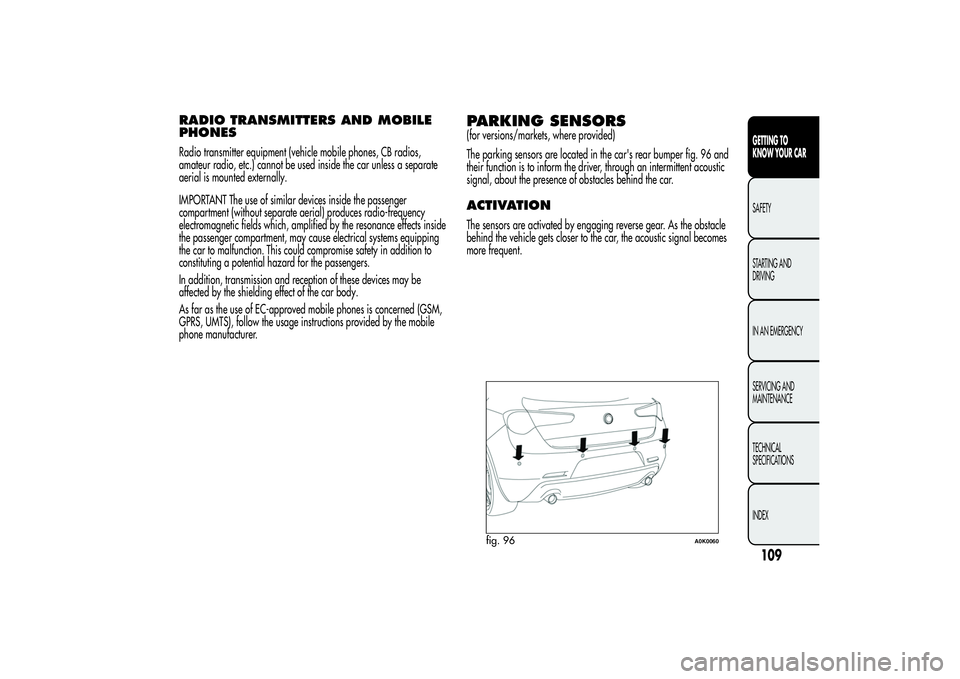
RADIO TRANSMITTERS AND MOBILE
PHONESRadio transmitter equipment (vehicle mobile phones, CB radios,
amateur radio, etc.) cannot be used inside the car unless a separate
aerial is mounted externally.
IMPORTANT The use of similar devices inside the passenger
compartment (without separate aerial) produces radio-frequency
electromagnetic fields which, amplified by the resonance effects inside
the passenger compartment, may cause electrical systems equipping
the car to malfunction. This could compromise safety in addition to
constituting a potential hazard for the passengers.
In addition, transmission and reception of these devices may be
affected by the shielding effect of the car body.
As far as the use of EC-approved mobile phones is concerned (GSM,
GPRS, UMTS), follow the usage instructions provided by the mobile
phone manufacturer.
PARKING SENSORS(for versions/markets, where provided)
The parking sensors are located in the car's rear bumper fig. 96 and
their function is to inform the driver, through an intermittent acoustic
signal, about the presence of obstacles behind the car.ACTIVATIONThe sensors are activated by engaging reverse gear. As the obstacle
behind the vehicle gets closer to the car, the acoustic signal becomes
more frequent.
fig. 96
A0K0060
109GETTING TO
KNOW YOUR CARSAFETY
STARTING AND
DRIVING
IN AN EMERGENCY
SERVICING AND
MAINTENANCE
TECHNICAL
SPECIFICATIONS
INDEX
Page 114 of 292
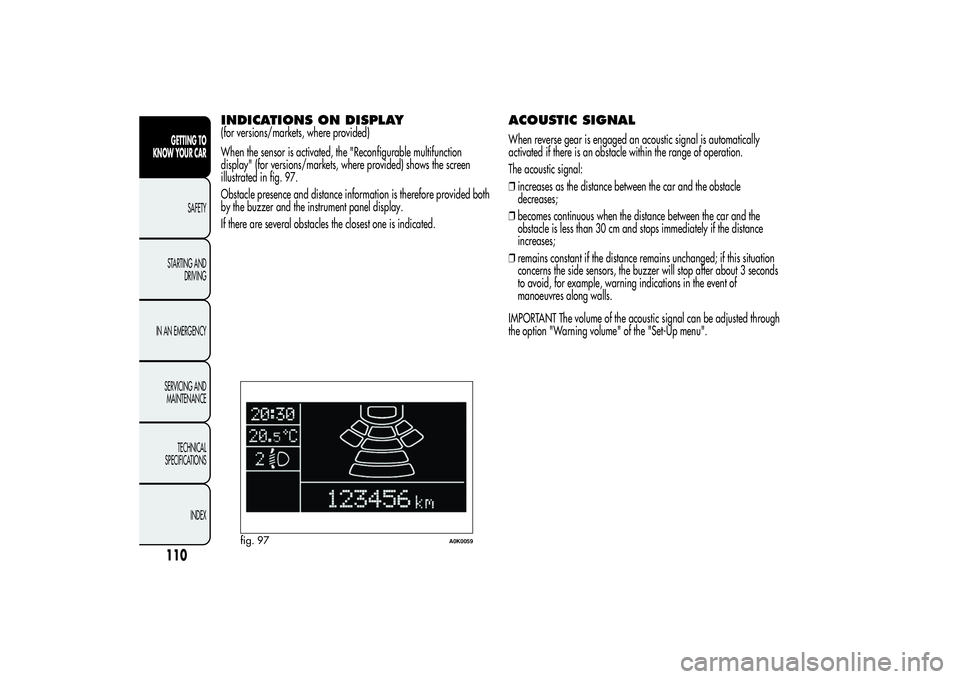
INDICATIONS ON DISPLAY(for versions/markets, where provided)
When the sensor is activated, the "Reconfigurable multifunction
display" (for versions/markets, where provided) shows the screen
illustrated in fig. 97.
Obstacle presence and distance information is therefore provided both
by the buzzer and the instrument panel display.
If there are several obstacles the closest one is indicated.
ACOUSTIC SIGNALWhen reverse gear is engaged an acoustic signal is automatically
activated if there is an obstacle within the range of operation.
The acoustic signal:
❒increases as the distance between the car and the obstacle
decreases;
❒becomes continuous when the distance between the car and the
obstacle is less than 30 cm and stops immediately if the distance
increases;
❒remains constant if the distance remains unchanged; if this situation
concerns the side sensors, the buzzer will stop after about 3 seconds
to avoid, for example, warning indications in the event of
manoeuvres along walls.
IMPORTANT The volume of the acoustic signal can be adjusted through
the option "Warning volume" of the "Set-Up menu".
fig. 97
A0K0059
110GETTING TO
KNOW YOUR CAR
SAFETY
STARTING AND
DRIVING
IN AN EMERGENCY
SERVICING AND
MAINTENANCE
TECHNICAL
SPECIFICATIONS
INDEX
Page 115 of 292
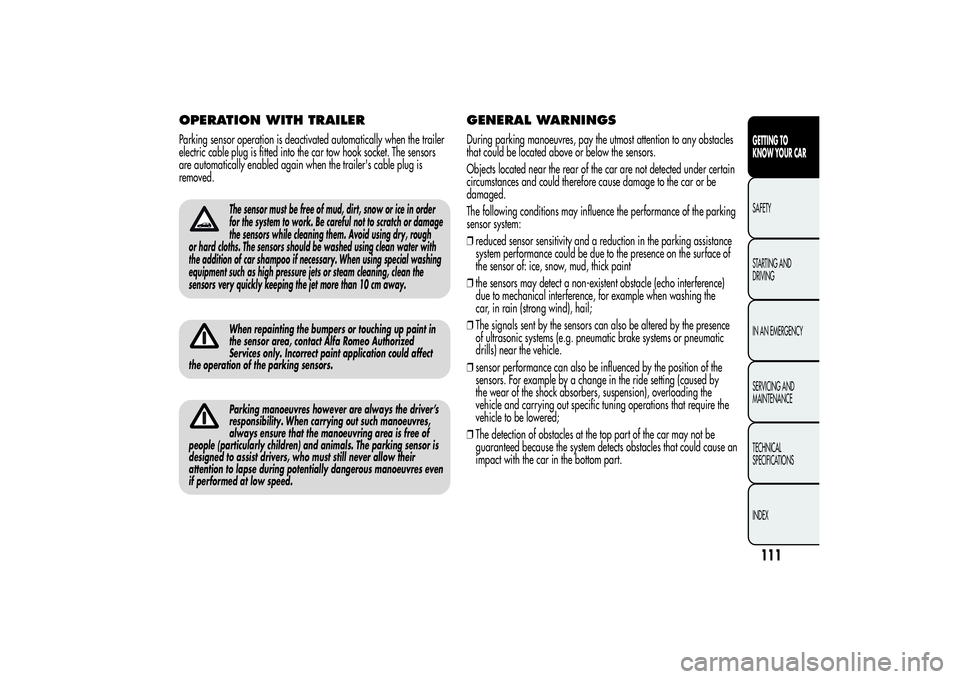
OPERATION WITH TRAILERParking sensor operation is deactivated automatically when the trailer
electric cable plug is fitted into the car tow hook socket. The sensors
are automatically enabled again when the trailer's cable plug is
removed.
The sensor must be free of mud, dirt, snow or ice in order
for the system to work. Be careful not to scratch or damage
the sensors while cleaning them. Avoid using dry, rough
or hard cloths. The sensors should be washed using clean water with
the addition of car shampoo if necessary. When using special washing
equipment such as high pressure jets or steam cleaning, clean the
sensors very quickly keeping the jet more than 10 cm away.When repainting the bumpers or touching up paint in
the sensor area, contact Alfa Romeo Authorized
Services only. Incorrect paint application could affect
the operation of the parking sensors.Parking manoeuvres however are always the driver’s
responsibility. When carrying out such manoeuvres,
always ensure that the manoeuvring area is free of
people (particularly children) and animals. The parking sensor is
designed to assist drivers, who must still never allow their
attention to lapse during potentially dangerous manoeuvres even
if performed at low speed.
GENERAL WARNINGSDuring parking manoeuvres, pay the utmost attention to any obstacles
that could be located above or below the sensors.
Objects located near the rear of the car are not detected under certain
circumstances and could therefore cause damage to the car or be
damaged.
The following conditions may influence the performance of the parking
sensor system:
❒reduced sensor sensitivity and a reduction in the parking assistance
system performance could be due to the presence on the surface of
the sensor of: ice, snow, mud, thick paint
❒the sensors may detect a non-existent obstacle (echo interference)
due to mechanical interference, for example when washing the
car, in rain (strong wind), hail;
❒The signals sent by the sensors can also be altered by the presence
of ultrasonic systems (e.g. pneumatic brake systems or pneumatic
drills) near the vehicle.
❒sensor performance can also be influenced by the position of the
sensors. For example by a change in the ride setting (caused by
the wear of the shock absorbers, suspension), overloading the
vehicle and carrying out specific tuning operations that require the
vehicle to be lowered;
❒The detection of obstacles at the top part of the car may not be
guaranteed because the system detects obstacles that could cause an
impact with the car in the bottom part.
111GETTING TO
KNOW YOUR CARSAFETY
STARTING AND
DRIVING
IN AN EMERGENCY
SERVICING AND
MAINTENANCE
TECHNICAL
SPECIFICATIONS
INDEX
Page 116 of 292
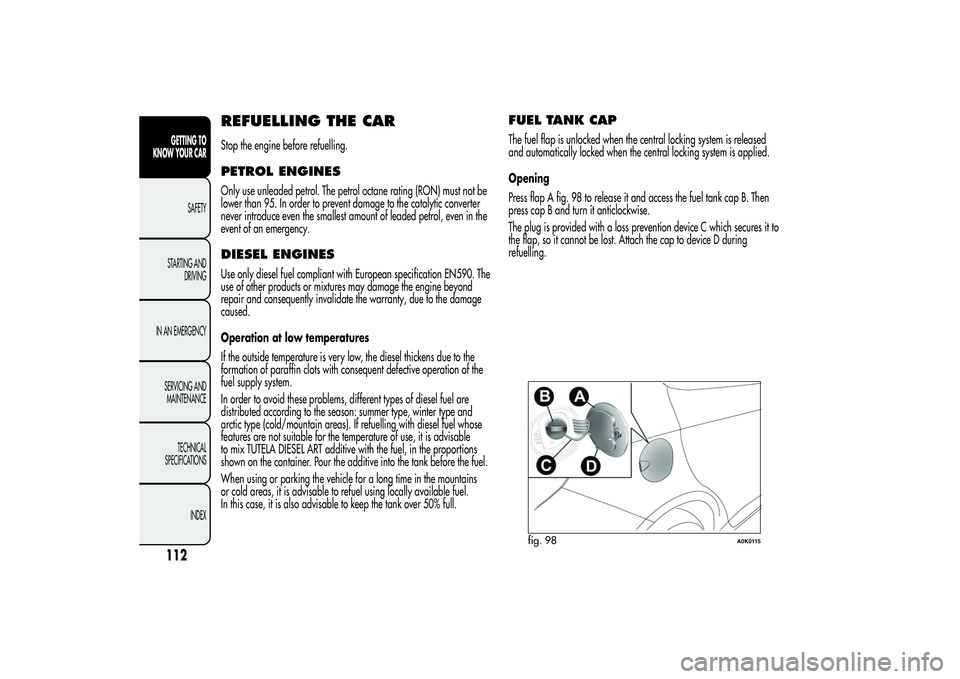
REFUELLING THE CARStop the engine before refuelling.PETROL ENGINESOnly use unleaded petrol. The petrol octane rating (RON) must not be
lower than 95. In order to prevent damage to the catalytic converter
never introduce even the smallest amount of leaded petrol, even in the
event of an emergency.DIESEL ENGINESUse only diesel fuel compliant with European specification EN590. The
use of other products or mixtures may damage the engine beyond
repair and consequently invalidate the warranty, due to the damage
caused.
Operation at low temperatures
If the outside temperature is very low, the diesel thickens due to the
formation of paraffin clots with consequent defective operation of the
fuel supply system.
In order to avoid these problems, different types of diesel fuel are
distributed according to the season: summer type, winter type and
arctic type (cold/mountain areas). If refuelling with diesel fuel whose
features are not suitable for the temperature of use, it is advisable
to mix TUTELA DIESEL ART additive with the fuel, in the proportions
shown on the container. Pour the additive into the tank before the fuel.
When using or parking the vehicle for a long time in the mountains
or cold areas, it is advisable to refuel using locally available fuel.
In this case, it is also advisable to keep the tank over 50% full.
FUEL TANK CAPThe fuel flap is unlocked when the central locking system is released
and automatically locked when the central locking system is applied.
Opening
Press flap A fig. 98 to release it and access the fuel tank cap B. Then
press cap B and turn it anticlockwise.
The plug is provided with a loss prevention device C which secures it to
the flap, so it cannot be lost. Attach the cap to device D during
refuelling.
fig. 98
A0K0115
112GETTING TO
KNOW YOUR CAR
SAFETY
STARTING AND
DRIVING
IN AN EMERGENCY
SERVICING AND
MAINTENANCE
TECHNICAL
SPECIFICATIONS
INDEX
Page 117 of 292
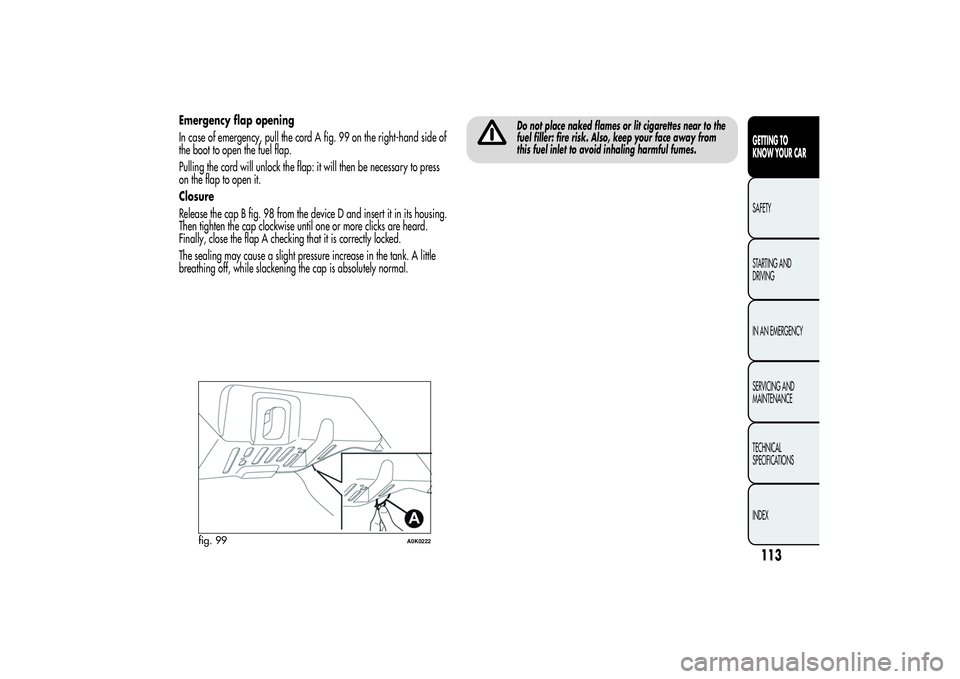
Emergency flap opening
In case of emergency, pull the cord A fig. 99 on the right-hand side of
the boot to open the fuel flap.
Pulling the cord will unlock the flap: it will then be necessary to press
on the flap to open it.
Closure
Release the cap B fig. 98 from the device D and insert it in its housing.
Then tighten the cap clockwise until one or more clicks are heard.
Finally, close the flap A checking that it is correctly locked.
The sealing may cause a slight pressure increase in the tank. A little
breathing off, while slackening the cap is absolutely normal.
Do not place naked flames or lit cigarettes near to the
fuel filler: fire risk. Also, keep your face away from
this fuel inlet to avoid inhaling harmful fumes.
fig. 99
A0K0222
113GETTING TO
KNOW YOUR CARSAFETY
STARTING AND
DRIVING
IN AN EMERGENCY
SERVICING AND
MAINTENANCE
TECHNICAL
SPECIFICATIONS
INDEX
Page 118 of 292
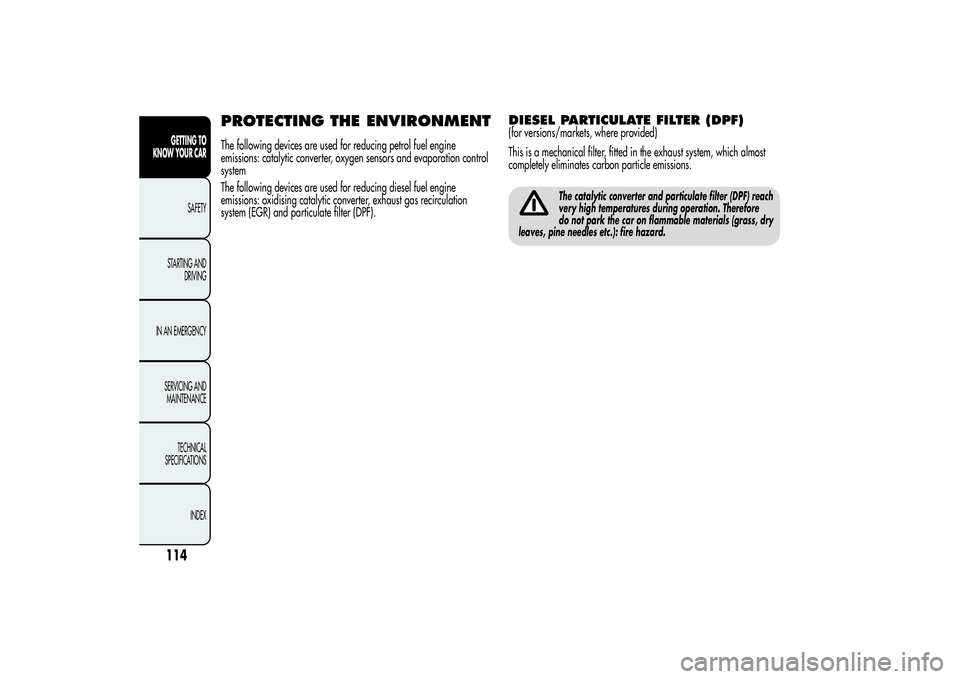
PROTECTING THE ENVIRONMENTThe following devices are used for reducing petrol fuel engine
emissions: catalytic converter, oxygen sensors and evaporation control
system
The following devices are used for reducing diesel fuel engine
emissions: oxidising catalytic converter, exhaust gas recirculation
system (EGR) and particulate filter (DPF).
DIESEL PARTICULATE FILTER (DPF)(for versions/markets, where provided)
This is a mechanical filter, fitted in the exhaust system, which almost
completely eliminates carbon particle emissions.
The catalytic converter and particulate filter (DPF) reach
very high temperatures during operation. Therefore
do not park the car on flammable materials (grass, dry
leaves, pine needles etc.): fire hazard.
114GETTING TO
KNOW YOUR CAR
SAFETY
STARTING AND
DRIVING
IN AN EMERGENCY
SERVICING AND
MAINTENANCE
TECHNICAL
SPECIFICATIONS
INDEX
Page 119 of 292
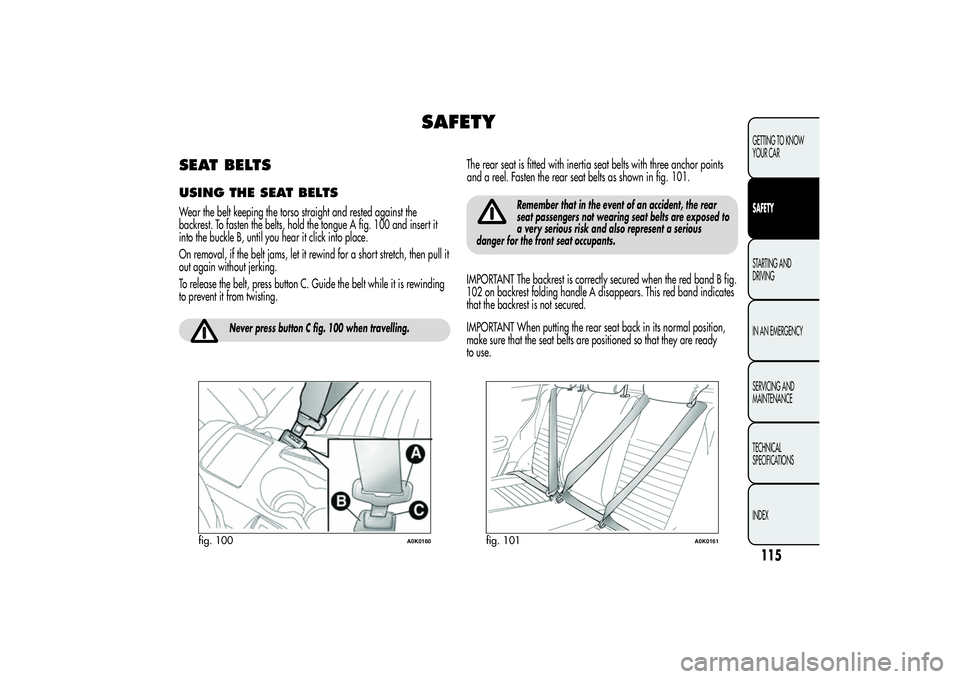
SAFETY
SEAT BELTSUSING THE SEAT BELTSWear the belt keeping the torso straight and rested against the
backrest. To fasten the belts, hold the tongue A fig. 100 and insert it
into the buckle B, until you hear it click into place.
On removal, if the belt jams, let it rewind for a short stretch, then pull it
out again without jerking.
To release the belt, press button C. Guide the belt while it is rewinding
to prevent it from twisting.
Never press button C fig. 100 when travelling.
The rear seat is fitted with inertia seat belts with three anchor points
and a reel. Fasten the rear seat belts as shown in fig.101.
Remember that in the event of an accident, the rear
seat passengers not wearing seat belts are exposed to
a very serious risk and also represent a serious
danger for the front seat occupants.
IMPORTANT The backrest is correctly secured when the red band B fig.
102 on backrest folding handle A disappears. This red band indicates
that the backrest is not secured.
IMPORTANT When putting the rear seat back in its normal position,
make sure that the seat belts are positioned so that they are ready
to use.
fig. 100
A0K0160
fig. 101
A0K0161
115GETTING TO KNOW
YOUR CARSAFETYSTARTING AND
DRIVING
IN AN EMERGENCY
SERVICING AND
MAINTENANCE
TECHNICAL
SPECIFICATIONS
INDEX
Page 120 of 292
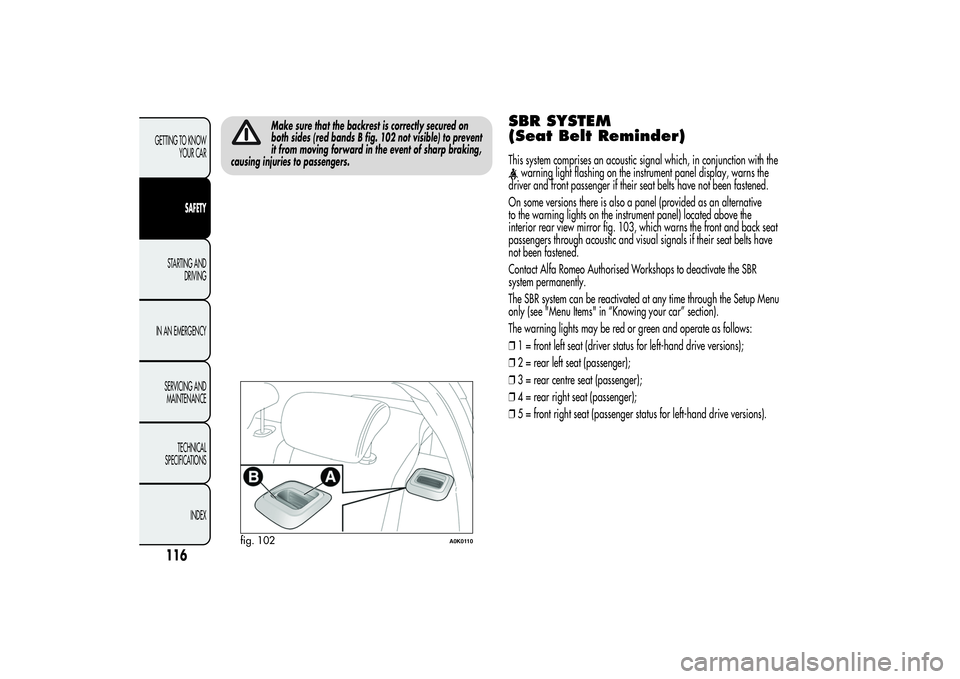
Make sure that the backrest is correctly secured on
both sides (red bands B fig. 102 not visible) to prevent
it from moving forward in the event of sharp braking,
causing injuries to passengers.
SBR SYSTEM
(Seat Belt Reminder)This system comprises an acoustic signal which, in conjunction with the
warning light flashing on the instrument panel display, warns the
driver and front passenger if their seat belts have not been fastened.
On some versions there is also a panel (provided as an alternative
to the warning lights on the instrument panel) located above the
interior rear view mirror fig. 103, which warns the front and back seat
passengers through acoustic and visual signals if their seat belts have
not been fastened.
Contact Alfa Romeo Authorised Workshops to deactivate the SBR
system permanently.
The SBR system can be reactivated at any time through the Setup Menu
only (see "Menu Items" in “Knowing your car” section).
The warning lights may be red or green and operate as follows:
❒1 = front left seat (driver status for left-hand drive versions);
❒2 = rear left seat (passenger);
❒3 = rear centre seat (passenger);
❒4 = rear right seat (passenger);
❒5 = front right seat (passenger status for left-hand drive versions).
fig. 102
A0K0110
116GETTING TO KNOW
YOUR CAR
SAFETY
STARTING AND
DRIVING
IN AN EMERGENCY
SERVICING AND
MAINTENANCE
TECHNICAL
SPECIFICATIONS
INDEX